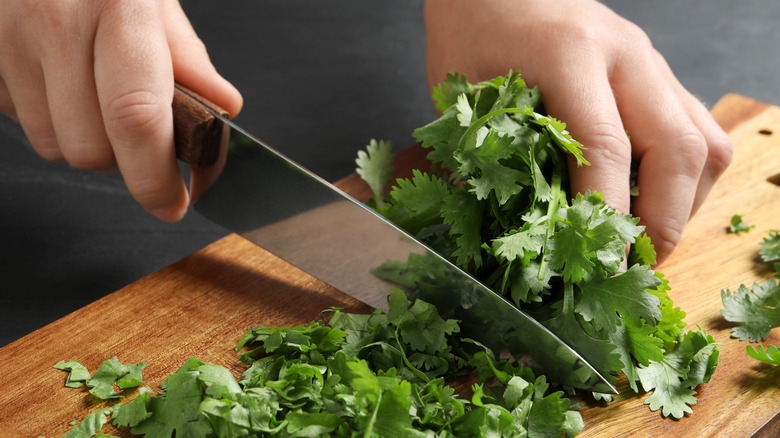You Won't Find One Divisive Herb In Ina Garten's Recipes
Beloved for her oh-so-chill demeanor, foolproof recipes, and no-fuss approach to entertaining, Ina Garten (aka the Barefoot Contessa) has never been shy about her culinary preferences. One ingredient she's famously not a fan of? Cilantro. In fact, she's gone so far as to say, "Not now. Not ever." And she's not alone. Julia Child once told Larry King the herb had a "dead taste." But these famous chefs' distaste for cilantro isn't about picky eating — it's rooted in science, sensory perception, and even genetics.
For people who love cilantro, it lends a bright, citrusy note that lifts salsas, curries, and salads. For others, like Garten, cilantro tastes like soap. This polarizing herb splits opinion like few others can and scientists have been exploring why for years. The divide over cilantro typically comes down to a genetic quirk. In 2012, researchers identified a genetic variant near the OR6A2 gene that's associated with perceiving cilantro's flavor as soapy or foul. If you have this gene variant, it's likely that cilantro triggers a less-than-appetizing response in your brain.
Beyond genetics, culture plays a role. In cuisines where cilantro is a staple (Mexican, Indian, Vietnamese, or Thai) people are often introduced to the herb early and regularly, which can reduce aversion. But if you didn't grow up with it (or have a strong genetic sensitivity), it might be difficult to ever warm up to it.
What to use instead of cilantro
If cilantro isn't for you, there are a few easy swaps that can offer a similar freshness or complexity, depending on the dish. Flat-leaf parsley is the most common substitute because it adds a clean, herbal note without the pungency of cilantro. If you're cooking a Southeast Asian or Italian dish, basil or Thai basil can provide a bright, slightly sweet alternative.
For a refreshing, cooling substitute, mint can replace cilantro in salads, desserts, and yogurt-based dishes. You can also combine herbs (such as a mix of parsley and mint) in dishes like tabbouleh or a Mexican chimichurri, where cilantro is more traditional. Some chefs recommend the trifecta of parsley, tarragon, and dill as the ultimate cilantro replacer.
If you're following a recipe that calls for cilantro, consider when and how it's being used. If it's added at the end as a garnish, the substitution is easy — just swap it with another fresh herb. If it's blended into a sauce, like a chutney or salsa verde, experiment with herbs that match the dominant flavor profile of the dish like the ones described above.
Garten's refusal to include cilantro in any of her cookbooks or recipes is a refreshing reminder that home cooking should bring joy, not dread. If cilantro ruins a dish for you, don't force it. There's no shame in swapping ingredients to suit your palate. After all, if the Barefoot Contessa can skip cilantro, so can you.

